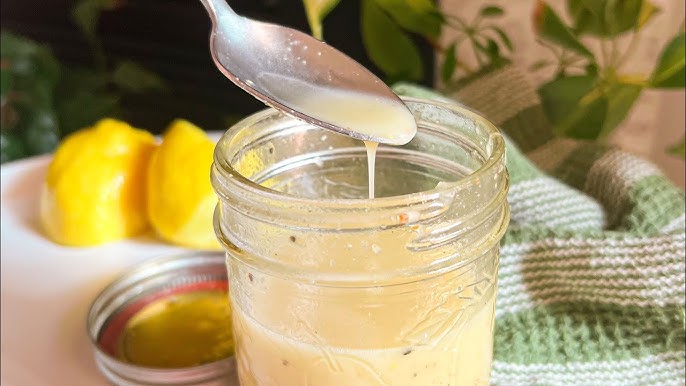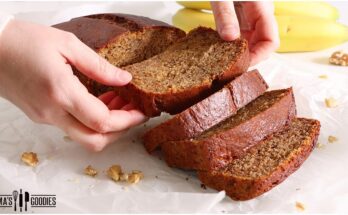Lemon Vinaigrette Recipe: Lemon vinaigrette is a simple, tangy, and fresh dressing made from lemon juice, olive oil, mustard, garlic, and seasonings. It is a fantastic way to add bright, citrusy flavors to any dish while keeping it light and healthy.
Why Make It at Home?
Homemade lemon vinaigrette is free of preservatives, artificial flavors, and unnecessary sugars. Plus, you can customize it to your taste and dietary needs while saving money compared to store-bought dressings.
Ingredients Needed
Essential Ingredients:
To make a classic lemon vinaigrette, you will need:
- Fresh lemon juice – About ¼ cup (from 1-2 lemons)
- Olive oil – ½ cup (extra virgin preferred)
- Dijon mustard – 1 teaspoon (adds creaminess and tang)
- Garlic – 1 clove, minced
- Honey or maple syrup – 1 teaspoon (optional, for sweetness)
- Salt – ½ teaspoon (or to taste)
- Black pepper – ¼ teaspoon
- Red pepper flakes (optional) – For a slight kick
Optional Additions for Extra Flavor:
- Fresh herbs – Basil, parsley, or thyme for added freshness
- Shallots – Finely minced for a more complex flavor
- Parmesan cheese – Adds a creamy, umami depth
- Balsamic or white wine vinegar – For extra acidity
Tools and Equipment
You don’t need fancy tools to make lemon vinaigrette, just:
- A citrus juicer (or your hands to squeeze the lemon)
- A whisk or mason jar for mixing
- A small bowl or measuring cup
- A garlic press or knife for mincing garlic
Step-by-Step Instructions
Step 1: Gather Ingredients
Make sure all ingredients are measured and ready to go. Fresh lemon juice is key, so avoid bottled lemon juice for the best taste.
Step 2: Juice the Lemon
Cut the lemon in half and use a juicer or your hands to extract the juice. Strain out any seeds to keep the dressing smooth.
Step 3: Combine Ingredients
In a small bowl, add the lemon juice, Dijon mustard, minced garlic, honey (if using), salt, and pepper.
Step 4: Whisk or Blend
- Whisk method: Slowly drizzle in the olive oil while whisking continuously. This helps emulsify the dressing and prevents separation.
- Jar method: Add all ingredients to a mason jar, seal it tightly, and shake vigorously until combined.
- Blender method: For a creamier vinaigrette, blend all ingredients in a small food processor or blender.
Step 5: Taste and Adjust
Try the vinaigrette and adjust seasoning as needed. If it’s too tangy, add more olive oil. If it’s too oily, add more lemon juice. A little more honey can balance out acidity.
Tips for the Best Lemon Vinaigrette
How to Balance the Flavors
The key to a great vinaigrette is balance. If it’s too sour, add a pinch of sweetness. If it’s too bland, increase salt or mustard.
Best Oils to Use
- Extra virgin olive oil is ideal for a rich, slightly peppery taste.
- Avocado oil offers a neutral, buttery flavor.
- Avoid vegetable or canola oil, as they can taste too processed.
Enhancing the Texture
A teaspoon of mustard helps emulsify the dressing, making it smooth and thick. Blending can also create a creamier consistency.
Ways to Use Lemon Vinaigrette
- Salad Dressing: Perfect for green salads, grain bowls, and pasta salads.
- Marinade: Works beautifully on chicken, shrimp, or tofu.
- Drizzle Over: Roasted vegetables, grilled meats, or even fresh bread.
Storage and Shelf Life
How to Store Properly
Keep your vinaigrette in an airtight container or mason jar in the fridge.
How Long Does It Last?
Homemade lemon vinaigrette lasts about 1 week in the fridge. Shake well before each use, as the ingredients may separate.
Customizing Your Vinaigrette
- Sweet Variations: Add honey, maple syrup, or agave for a sweeter touch.
- Herb-Infused: Blend in fresh basil, parsley, or chives.
- Spicy Kick: Add a pinch of red pepper flakes or a dash of hot sauce.
Common Mistakes to Avoid
- Too sour? Add more oil or a touch of honey.
- Too oily? Increase lemon juice or mustard.
- Not emulsified? Whisk thoroughly or blend for a smooth texture.
FAQs about Lemon Vinaigrette Recipe
1. What ingredients are needed for lemon vinaigrette?
Lemon vinaigrette typically requires just a few simple ingredients: fresh lemon juice, olive oil, minced garlic, Dijon mustard, honey or sugar for a touch of sweetness, salt, and pepper. Some variations might include herbs like basil or thyme for added flavor.
2. How do you make lemon vinaigrette?
To make lemon vinaigrette, whisk together lemon juice, olive oil, garlic, Dijon mustard, honey or sugar, salt, and pepper in a bowl. You can also shake the ingredients together in a jar with a tight-fitting lid. For a smoother texture, some prefer to blend the ingredients using a food processor or blender.
3. Can lemon vinaigrette be made in advance?
Yes, lemon vinaigrette can be prepared in advance and stored in the refrigerator. It typically keeps well for up to a week. Before using, give it a good shake or stir to re-emulsify the ingredients.
4. Is lemon vinaigrette healthy?
Lemon vinaigrette can be a healthy dressing option, as it is made with simple, whole ingredients. Olive oil provides healthy fats, lemon juice is a good source of vitamin C, and using honey adds a natural sweetness. To keep it healthier, be mindful of the oil-to-lemon juice ratio and the amount of salt and sugar used.
5. What salads pair well with lemon vinaigrette?
Lemon vinaigrette is versatile and pairs well with a variety of salads. It’s especially good with mixed greens, arugula, spinach, and kale. It also complements salads that include fruits like apple or pear, vegetables like asparagus or artichokes, and proteins like chicken or salmon.
6. How can you customize lemon vinaigrette?
You can customize lemon vinaigrette by adding different herbs, spices, or additional ingredients. Consider incorporating chopped fresh herbs, red pepper flakes for heat, or a splash of balsamic vinegar for depth. Adjusting the garlic, mustard, and honey can also tailor the flavor to your liking.
Lemon vinaigrette is a simple yet flavorful dressing that enhances any dish. Whether you’re tossing it on a salad, using it as a marinade, or drizzling it over roasted veggies, it’s sure to elevate your meals with its bright and refreshing taste.



